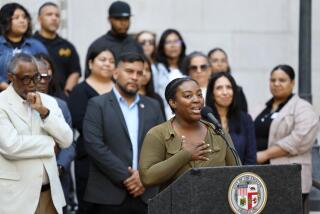Freenets Getting a New Lease on Life
- Share via
Ask Doris Dell of Woodland Hills what she can’t live without and she answers without hesitation: “I’m retired, and the Internet is my whole life.”
Dell’s hobby is genealogy and she uses the Net to help track down family trees.
But it’s not just a hobby for her. For Dell, and many others, the Internet is a connection to humanity, a way of reaching out to people who would otherwise be inaccessible. “The contacts I’ve made on the Internet have become very important to me. Like I said, it’s a major part of my life.”
But Dell never would have made the connection without the Los Angeles Free-Net, which offers Internet access at a very low cost at www.lafn.org. “When I got started doing this, I couldn’t have afforded anything more than $40 a year for Internet access. The people behind this are doing a wonderful thing.”
For many Americans, an Internet connection has become a lifeline to the world, rivaling the telephone in importance. Roberta D. Godfrey of Culver City, who’s also an LAFN user, said, “I do a tremendous amount of research on the Internet. The Internet is my comfort and a critical source of information. I wouldn’t buy a thing without comparing specifications and prices online. Information obtained from the Internet improves life and the poor deserve the same access as the rich.”
For Dell, Godfrey and thousands of Americans, Internet access is a critical tool, but many cannot easily afford it. With standard access rates averaging more than $200 a year, it’s easier for people of limited means to get a computer than it is to maintain an Internet connection.
Most free commercial Internet providers have bit the dust. Those still around severely limit the amount of time users can spend online each month. Which is why the freenet movement is being resurrected in America, after years of decline.
Freenets, which offer cheap or free Internet service and are usually staffed by volunteers, began in Cleveland in 1986. Over the next decade, thousands--some say tens of thousands--of community-based network providers sprang up all over the country.
The volunteers were inspired by the power of network communications, seeing a day when people would routinely use a computer to read a newspaper story, download a form from a government agency or look up the latest medical information.
At a time when residents of many communities didn’t have access to a commercial Internet feed without making a long-distance call, these community projects helped America get wired. The government forces the telephone companies to provide subsidized telephone service for the poor, but no such plan exists for Internet access.
Freenets stepped up to the plate.
But as commercial providers built out and offered flat-rate Internet access for $20 a month, membership in freenets began declining. When companies such as Juno and NetZero started giving away Internet, most of the freenets withered away.
A few survived, however, and with the need for low-cost Internet access still acute today, these organizations are answering the call.
Using some systems is like a trip back in time. For instance, the Silicon Valley Public Access Link in San Jose has room on the system for only 24 users. And most of those connections run at 33K, far slower than the maximum--and, today, standard--dial-up speed of 56K.
But other freenets, aided by advances in technology combined with plunging prices, have dramatically expanded their systems, offering users performance comparable to that of a commercial provider.
For instance, the Los Angeles Free-Net was moribund for years after it was founded in 1994. But by January it will offer local dial-up access from nearly anywhere in California and hopes tens of thousands of Californians will join up.
One of 10 founders of the nonprofit, Avrum Bluming, is an Encino physician specializing in the treatment of cancer. He said his group’s project has been reinvigorated by the growing need for better connectivity for the poor. The LAFN charges $40 annually for an account, a figure that will rise to $50 next year. That’s less than a quarter of what a commercial ISP would charge, and the fee is waived for those who can’t afford it.
In six years, the project has grown from a handful of volunteers to several hundred. Currently about 5,000 people have accounts on the system, but hardware improvements mean 25,000 can be accommodated.
The system has a loyal following. “I tried three other providers, but they were all so darned expensive,” said Emelie Levinson of Brentwood, a user for six years. The Internet is a critical communication device for her, allowing her to stay in touch with friends and get information on demand. “And this is only $40 a year as opposed to $200,” she said.
One of the things you’ll find on the LAFN is what’s probably the finest repository of medical information on the Internet. “There’s a team of doctors who screen all the information on there,” Bluming said.
Offering people an anonymous and safe way to ask medical questions was actually his original impetus for helping launch the LAFN, he said,
“It’s really important to give everybody--everybody--access to this kind of technology. Just from my own little narrow window on the world, I know this can help people. I think we’re the best-kept secret in Los Angeles, and that’s a tragedy.”
*
Dave Wilson is The Times’ personal technology columnist. He can be reached at dave.wilson @latimes.com.
More to Read
Inside the business of entertainment
The Wide Shot brings you news, analysis and insights on everything from streaming wars to production — and what it all means for the future.
You may occasionally receive promotional content from the Los Angeles Times.










